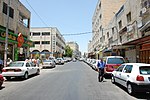St. Stephen's Basilica, Jerusalem
20th-century Roman Catholic church buildingsBasilica churches in JerusalemBuildings and structures in JerusalemRoman Catholic churches completed in 1900Roman Catholic churches in Jerusalem ... and 1 more
École Biblique

The St. Stephen's Basilica (Hebrew: מנזר סנט אטיין) or simply the Church of St. Stephen, also known by its French name, Saint-Étienne, is the name given to a Catholic church located outside the walls of the Old City of Jerusalem, on the road leading north to Nablus. It is next to the convent of St. Stephen, home to the French Bible and Archaeology School (École biblique et archéologique française de Jérusalem), and the convent church. An old tradition sees this place as the place where the martyrdom of Saint Stephen took place, the martyr deacon mentioned in the book of Acts (Acts 7: 54–60). A rival site is located in the Kidron Valley.
Excerpt from the Wikipedia article St. Stephen's Basilica, Jerusalem (License: CC BY-SA 3.0, Authors, Images).St. Stephen's Basilica, Jerusalem
Ibn Al-As, Jerusalem Bab a-Zahara
Geographical coordinates (GPS) Address Nearby Places Show on map
Geographical coordinates (GPS)
| Latitude | Longitude |
|---|---|
| N 31.785 ° | E 35.23 ° |
Address
École biblique et archéologique française
Ibn Al-As 6
9119001 Jerusalem, Bab a-Zahara
Jerusalem District, Israel
Open on Google Maps









